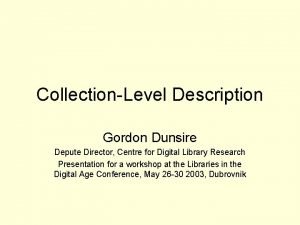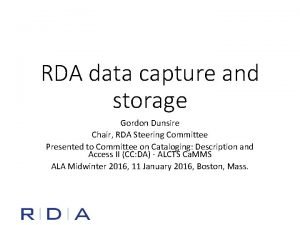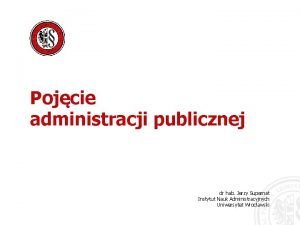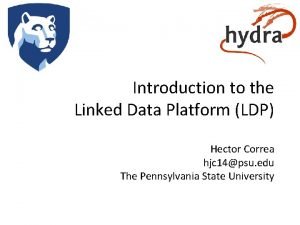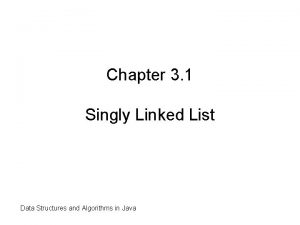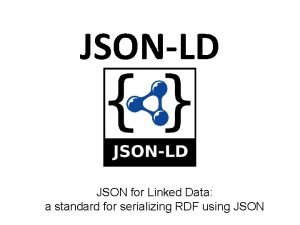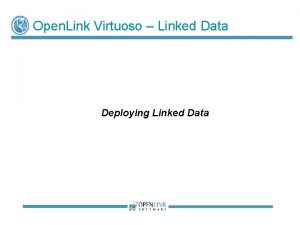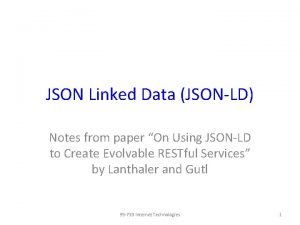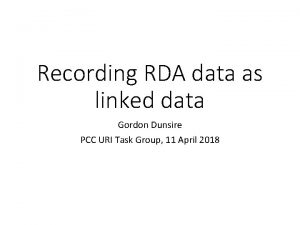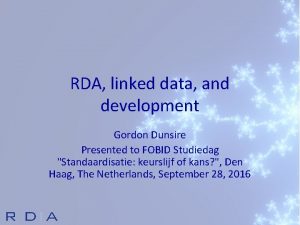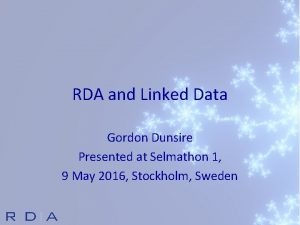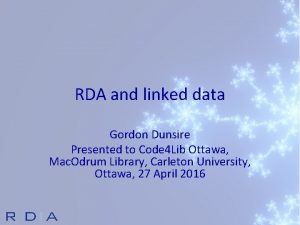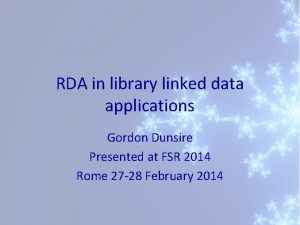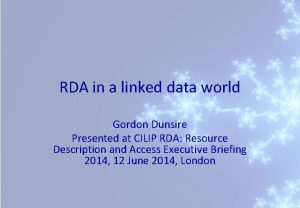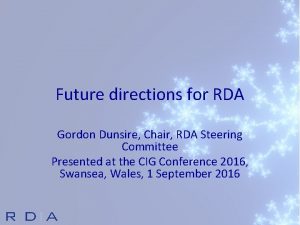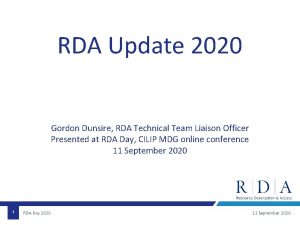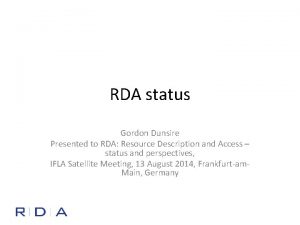RDA Community and linked data Gordon Dunsire LD











- Slides: 11

RDA Community and linked data Gordon Dunsire LD 4 Workshop, 1 May 2018

Kinds of recorded data RDA is designed to support a wide range of data carrier architectures for storage and display Flat-file: card and other print-based catalogues Bib/Authority: MARC, etc. Local (Closedworld) RDBMS: Table for each entity, row keys (IDs) RDF: Classes, properties, and IRIs Global (Openworld) RDA uses RDF to record data for RDA Reference (entities, elements, and vocabulary encoding schemes) RDA/RDF provides data for • RDA Toolkit (Glossary, element reference, navigation) • Available from RDA Registry under open license

RDA recording methods RDA provides instructions for four methods of recording data values: Unstructured description Transcription; free-form notes; uncontrolled human-readable appellation (name, title) Structured description Multiple values with string encoding scheme; value with syntax encoding scheme; controlled human-readable appellation (access point) Identifier Machine-readable appellation (local) IRI Machine-readable appellation (global) An appellation references an instance of an entity

Recording methods for related data RDA Entity 1 "note on related entity 2" Keyword index "access point for related entity 2" Authority file is related to "identifier for related entity 2" RDA Entity 2 Standard identifier system Semantic Web

Strings, things, and Nomens Entity (thing) has appellation Timespan Nomen has nomen string “nomen string" has status of identification has date of usage Name Authority file Status (VES)

Beyond RDA is an implementation of the IFLA Library Reference Model RDA Entity rdfs: sub. Class. Of LRM Res Domains and ranges of properties are specified as RDA entities RDA unconstrained properties do not specify domain or range Definition terms are given “in the vernacular”: no special meaning is intended for “resource” or “agent”. RDA property rdfs: sub. Property. Of RDA unconstrained (not LRM)

Super-class of all RDA entities IFLA LRM and RDA entities Res is sub-class of has appellation RDA Entity Nomen Work Expression Manifestation is created by Place Agent is modified by Item is sub-class of Person LRM relationship refined as RDA element sub-type (RDF sub-property) Family is associated with Timespan Collective Agent Corporate Body

Ontology representation Canonical property (no range) is sub-property of Datatype property (Literal/string range) Unstructured description Structured description with associated string/syntax encoding scheme Identifier with associated string/syntax encoding scheme Object property (specific/thing range) Range = RDA entity for IRI of instance of related entity Range = VES class for IRI of concept from vocabulary encoding scheme Each type of property is in a separate element set with shared local identification (URI part)

Extending/refining RDA Element RDA property Entity Alternative label RDA class Narrower property Value RDA Vocabulary RDA Term/Concept Narrower term Alternative vocabulary Alternate label

Linking RDA data RDA uses RDF maps to link RDA entities, elements, and terms to external vocabularies Map = set of mappings between source and target elements, etc. Usually published in Terse Triple Language or N-triple serializations If there is no target representation in RDF, “map” is published as an alignment (data crosswalk, not linked data)

Thank you! • rscchair@rdatoolkit. org • http: //www. gordondunsire. com/presentations. htm
